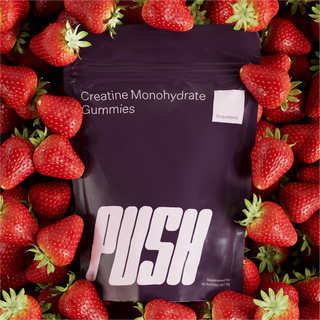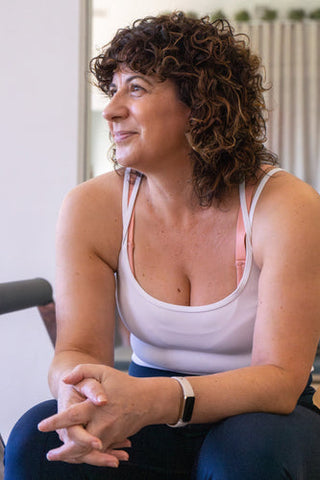We’ve talked a lot about the myths surrounding cardio and strength training, but there’s another important aspect of your fitness routine that we want to discuss … stretching! Have you ever found yourself wondering why at the beginning and end of many Aleenta classes, and even between exercises, there is always some type of stretching? Well, it’s not just to provide a release in the moment; regular stretching has incredible long-term benefits, which is why we have an entire YouTube series dedicated to stretch and mobility. By following along with Meg in her 7-class series, in combination with the knowledge from this very guide, you’ll be able to create your own personal stretching routine to last a lifetime!
Part 1: Why stretching is just as important as cardio and strength training.
As we’ve mentioned in other blogs, cardio is great for your cardiovascular health, while strength training keeps your bones and muscles strong. So, what’s the deal with stretching? As we age, a long-term stretching routine comes in handy to not only maintain our health, but combat musculoskeletal pain that can lead to reduced mobility. Without adequate mobility, it becomes harder to continue cardio and strength training leading to decreased fitness overall. Hence, the importance of stretching quickly becomes clear.
Stretching also engages connective tissue, including ligaments and fascia, which serve as the links among the muscles, bone, blood vessels, and organs! Why is this important to know? A 2022 scientific review notes that common pathological fascias such as chronic low back pain, chronic neck pain, and Dupuytren's disease, are often characterised by increased tissue stiffness; markers of inflammation are also documented in the connective tissue (i). Scientific literature in this topic is limited, however, preliminary research such as this 2015 study in rats does suggest positive results when using stretching to decrease inflammation in connective tissues (ii). Perhaps that’s why many Doctors recommend stretching for treatment of pathological fascias such as plantar fasciitis!
Long-term effects of chronic inflammation can contribute to cardiovascular disease, cancer and type 2 diabetes, so keeping our connective tissue healthy and mobile is another reason to incorporate more stretching into your routine (iii). That’s not to say that neglecting to stretch will cause your fascia to become inflamed, however, injuries certainly can. Unfortunately, there isn’t much conclusive research that proves stretching can prevent an injury; it is simply an associated risk of exercising, especially at higher intensities.
Are there studies that prove any benefits to stretching?
The short answer is… yes! Several different studies conclude:
- Stretching increases blood flow to muscles, providing more nutrients and decreased muscle soreness. (iv)
- Stretching increases your range of motion, which is important in staying mobile especially as we age. (v)
- Stretching boosts serotonin levels, presenting benefits for mental health as well! (vi)
Part 2: How stretching really works
One of the most well-known myths surrounding stretching is how it actually works. Contrary to popular belief, when you stretch you aren’t training the muscle; you’re actually training your brain! This is called “sensory theory”, and has been supported by research published in the Scandinavian Journal of Science & Medicine in Sports (vii). The theory posits that repeated stretching teaches your brain to gradually tolerate a greater range of motion in a stretch, rather than the muscle itself actually becoming altered overtime.
It’s common knowledge that we tend to be hyper-flexible as children, then as we age that mobility gradually deteriorates. This is due to the development of your nervous system. When we are young, we’re still learning. A simple example is if you ever touched a hot stove as a child: the first time this happens your brain records a pain response, and you quickly learn that some things are better left untouched. The same concept occurs between your brain and your muscles!
As you grow, your brain learns the necessary ranges of motion (ROM) required for each muscle in your body and their respective activities such as sitting, standing, walking, and running. Once we’re fully developed, the brain has built an entire library of how much each muscle needs to move; this is called kinaesthetic memory and is more commonly referred to as ‘muscle memory.’ When we go to move beyond that range of motion, it triggers a nervous response that further extension (stretching) is not needed and could potentially cause harm, since that is what our brains learnt and tolerate. But fear not, because no matter your age, you can retrain your brain!
Part 3: How to retrain your brain… aka, the best way to stretch!
The first, and most important, thing to know about stretching is that you should always warm up beforehand; cold muscles are more prone to pulling, straining and/or tearing. There are several different ways to stretch, but in this guide, we’ll cover the main three since these are the types of stretches you encounter in Meg’s series.
- Static/Passive Stretching
Static stretches are the most well-known type of stretching. To perform a static stretch, you extend a muscle to the fullest range of motion and hold it there. This is also sometimes referred to as a passive stretch when there is something holding the muscle in place, such as the floor or your hand. This includes the splits, forward folds, the figure-4 glute stretch, and countless more. The American College of Sports Medicine reviewed a wide range of studies pertaining to how long you should hold a static stretch, and the general consensus is 15 – 60 seconds (viii). For the best results, spending 60 seconds in a stretch is ideal, but it doesn’t have to be done all at once; you can break it up into 3, 20 second holds if that’s more accessible for you. They also recommended that adults should perform these stretches 2-3 times a week, so if you attend 2-3 classes a week, or substitute with one of Meg’s, you’re already doing great!
- Dynamic Stretching
Think of dynamic stretching like a moving stretch, as opposed to being held. Examples include leg and arm swings, or torso twists. Ideally, you should start a dynamic stretch in a small ROM and gradually increase the reach and/or speed of the movement over 8-12 repetitions (ix). Eventually, the range of motion you move through should naturally increase, so your leg swings a little higher overtime, or your torso twists a little further. Dynamic stretches are great to tack on to the end of your warm-up since they maintain the flow of movement.
- PNF Stretching
PNF stands for proprioceptive neuromuscular facilitation, and is the most effective type of stretching for increasing range of motion. Remember, maintaining a large range of motion is ideal for our mobility, especially as we age! Here’s how it works:
- Enter into a passive stretch, with some form of resistance. For this example, we’ll use lizard pose from yoga where the resistance comes from the floor.

- Whilst in the stretch, contract the target muscle, which in this case is the iliopsoas or hip flexor. You can think about squeezing your front foot and back knee together to execute this contraction.
- After a short hold, release the contraction back into the passive stretch. You may notice your ROM has deepened!
PNF stretching should only be done after a workout or on its own. Studies have shown that if PNF is performed either after or without exercise it actually increases muscular performance (x)! However, don’t go trying to contract your muscles mid-stretch without proper guidance at first. Follow along with Meg and try some of the PNF stretches she includes in her series so you are performing them safely.
Part 4: What makes a stretch safe?
Like any form of exercise, there are risks that we should be aware of in order to minimise any potential injuries. So, what are the best ways to ensure you are stretching safely?
- Always warm-up
As previously mentioned, you should never stretch without warming up beforehand. According to Harvard Medical School, this can be as simple as marching on the spot with some arm swings, dancing to a few of your favourite songs, or even taking a hot shower (xi).
- Never bounce in a stretch
Bouncing in a stretch is technically a type of stretching referred to as ballistic stretching. However, this type of stretching is highly advised against as it has been shown to cause muscles to tighten, leading to injury. Stretches should always allow the muscle to gradually relax into position.
- Use proper technique and form
Just as doing a squat with poor form is dangerous, stretching without technique will not yield the results you seek. Alignment is especially important to make sure a muscle is being stretched in the proper position. If you are unfamiliar with the correct form of a stretch, or simply unsure, it is best to take stretches directly from class where your instructor not only cues alignment, but can personally assist and guide you. Our classes on YouTube are the perfect way to learn proper form for free!
- Good pain VS bad pain
When stretching, there’s bound to be some tension on the muscles that is often equated to ‘good pain.’ It’s part of your nervous response; your brain is telling you not to push that muscle any further. This sensation may feel uncomfortable, which is perfectly normal. Breathing through a stretch is a great technique to employ that can help alleviate this uncomfortable tension. However, this feeling should never be unbearable; if you ever experience sharp, sudden pain while stretching, immediately get out of that position. Navigating good and bad pain can be tricky, so if you want to learn more, head over to the Aleenta Training Journal where Dr Dan Harvie, musculoskeletal physiotherapist and Aleenta Instructor Training co-creator, talks in-depth about this concept.
Part 5: Get stretching!
We’ve covered everything you need to know as a beginner stretcher; the only thing left to do now is stretch! Begin by adding stretching to your fitness routine 2-3 times a week. If you already stretch in-class, start taking note of any stretches you may want to bring home with you. Experiment with the different types of stretching: if you are quite stiff and inflexible, the PNF method may be your go-to to best increase your range of motion. If you spend a lot of time sitting at the office, you may find dynamic stretches to be more useful for you. Unsure which muscles to stretch? The best muscle groups to focus on for the everyday lifestyle include the neck, shoulders, chest, torso, lower back, hips, legs, and ankles, and should make up the base of your routine. This may seem like a lot, so if you’re a little overwhelmed, don’t worry… you can always refer back to this guide, and of course, Meg is always available to help!

Interested in other ways to increase your range of motion and keep yourself mobile long into your life? A recent study suggests strength training could be just as successful as stretching! Read it here.
Written by Sascha Czuchwicki
Works Cited
i) Kondrup, Flemming et al. “The deep fascia and its role in chronic pain and pathological conditions: A review.” Clinical anatomy (New York, N.Y.) 35,5 (2022): 649-659. doi:10.1002/ca.23882
iii) The President and Fellows of Harvard College. The importance of stretching. 14 March 2022. 7 September 2022. <https://www.health.harvard.edu/staying-healthy/the-importance-of-stretching>.
iv) Deshmukh, Vijay Y. "Health Benefits Of Stretching." Aayushi International Interdisciplinary Research Journal5 (2019): 123-126.vii) Freitas, S R and et al. "Can chronic stretching change the muscle-tendon mechanical properties? A review." Scandinavian Journal of Science & Medicine in Sports 28.3 (2017): 794-806.
viii) The President and Fellows of Harvard College. The ideal stretching routine. 1 March 2021. 7 September 2022. <https://www.health.harvard.edu/staying-healthy/the-ideal-stretching-routine>.
ix) Appleton, Bradford. STRETCHING AND FLEXIBILITY: Everything you never wanted to know. Boston, 9 January 1996. Document. <https://web.mit.edu/tkd/stretch/stretching_4.html#SEC28>






